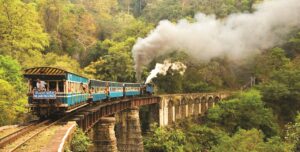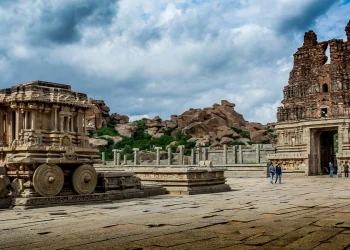The Mountain Railways of India traverse some of the most picturesque landscapes in the country. The first of these railways opened in 1881, and the last was completed in 1908. Together, they connect remote and mountainous regions to the rest of the country.
From the Darjeeling Himalayan Railway to the Nilgiri Mountain Railway to the Kalka Shimla Railway, the Mountain Railways of India are an impressive example of ingenious engineering. Constructing effective rail links across the mountains was no small feat; it required bold engineering solutions and a great deal of skill and expertise.
Today, these railways are still in use, providing a unique window into the stunning beauty of India’s mountain ranges. UNESCO also recognizes them as a World Heritage Site, a testament to their historical significance.
Darjeeling Himalayan Railway
The Darjeeling Himalayan Railway is a truly remarkable feat of engineering. Opened in 1881, it was the first hill passenger railway, and it remains the most impressive example of its kind. The railway was constructed to provide an effective rail link across the mountainous terrain of the Himalayas.
Despite the extreme altitude and rugged landscape, engineers devised a system of tracks and bridges that allowed for easy passage. This ingenious design was achieved using bold engineering solutions, such as zig-zag track sections, loops and spirals.
![]()
The train travels through the beautiful Himalayan foothills, offering breathtaking views of the surrounding mountains and tea plantations. This 2 feet (0.610 meters) gauge railway connects New Jalpaiguri with Darjeeling, winding its way through steep slopes and difficult terrain.
It covers a total distance of 88.48 kilometres and passes through Ghoom (India’s highest railway station) at an elevation of 2258 meters. Built between 1879 and 1881, the DHR was designed to overcome the steep gradients of the terrain, and it does this with a series of zig-zag reverses and loops.
Also read: A Short Guide To Attending A Dalai Lama Teaching In Dharamshala
The ruling gradient of 1:31 is what makes this railway so unique and enables it to traverse the slopes of the mountains while still providing a safe and comfortable journey.
On 5 December 1999, UNESCO declared the Darjeeling Himalayan Railway (DHR) a World Heritage Site. The Darjeeling Himalayan Railway is a testament to its designers’ ingenuity and is an iconic symbol of India’s grand engineering heritage.
The journey takes around seven hours and is a great way to experience the beauty of the Himalayas. As you pass through tea gardens, forested hills, and sprawling valleys, you will feel like you are in a different world. It’s an unforgettable journey that is sure to be the highlight of your trip to India.
Nilgiri Mountain Railway
The Nilgiri Mountain Railway is a unique railway line in Southern India. It is a 45.88-kilometre-long meter-gauge single-track railway that connects the town of Mettupalayam with the hill station of Udagamandalam (2203m), also known as Ooty, in Tamil Nadu. The idea of constructing such a railway was first proposed in 1854. However, due to the challenging terrain, construction work did not begin until 1891.
Over the next 17 years, engineers overcame many obstacles to complete the project in 1908. The railway is still in use today and is one of the few meter-gauge heritage railways still operating in India. In 2005, the Nilgiri Mountain Railway was declared a UNESCO World Heritage Site and has become a popular tourist attraction.

The Nilgiri Mountain Railway is considered one of India’s most scenic train journeys, offering spectacular views of the area’s lush green tea plantations and forested slopes. The route runs through the Nilgiri Hills, known as the Blue Mountains of Southern India due to their picturesque beauty.
The Nilgiri Mountain Railway is the only rack railway in India and uses an Abt rack system. This system helps the train gain traction on the steep inclines of the hills so that it can climb up to Udagamandalam.
Also read: Explore Lakshadweep: A Complete Travel Guide
The journey between Mettupalayam and Udagamandalam takes around five hours. During the journey, the train passes through lush green valleys, tea gardens, waterfalls and forests. It also passes over 16 bridges and 250 curves, providing spectacular views of the surrounding countryside.
The Nilgiri Mountain Railway is a magnificent way for travellers to experience the beauty of Southern India in a unique and memorable way.
Kalka Shimla Railway
The Kalka-Shimla Toy Train is a beloved slice of Indian railway history. It is an old-fashioned, narrow-gauge railway that runs through the Himalayan foothills and takes passengers on a scenic journey from Kalka to Shimla.
The journey takes about five and a half hours, and it is a lovely ride, passing through 102 tunnels, over 900 bridges, and around numerous curves and loops.
Also read: Six Amazing Holiday Destinations For Yoga Lovers In India
The train was first opened in 1903 and has been in operation ever since. In 2008, it was declared a UNESCO World Heritage Site for its historical significance.
The 96 km-long track was built between 1898 and 1903 and was a major engineering feat of the late 19th century, as it was built through difficult terrain and challenges, including steep gradients and over a hundred tunnels.
![]()
The Kalka Shimla Railway is a testament to the engineering skills of its creators. It is one of the most iconic railways in India, and its construction was no small feat. The world’s highest multi-arc gallery bridge and the world’s longest tunnel (at the time of construction) were both parts of this railway. It was a monumental task to build such a railway in the 19th century, especially when the terrain was so difficult.
![]()
Although the Kalka-Shimla Toy Train may not be as fast as modern trains, it is certainly one of the most scenic and memorable journeys you can take. The train chugs along leisurely, giving passengers plenty of time to take in the scenery.
For many travellers, riding the Kalka-Shimla Toy Train is a once-in-a-lifetime experience and one that is not to be missed! It is a living cultural icon that is both a reminder of India’s colonial past and a symbol of timeless beauty.
Rupesh Kumar is an accomplished Journalist, Author, Graphic Designer, and Strategic Thinker. He has worked with scores of news and sports channels in India and is an expert in crafting engaging & informative content.











